Abstract
Calonectria species are important plant pathogens on a wide range of hosts, causing significant losses to plant production worldwide. During our survey on phytopathogenic fungi from 2019 to 2021, diseased samples were collected from various hosts in Guangdong Province, China. In total, 16 Calonectria isolates were obtained from leaf spots, stem blights and root rots of species of Arachis, Cassia, Callistemon, Eucalyptus, Heliconia, Melaleuca and Strelitzia plants. Isolates were identified morphologically, and a multigene phylogenetic analysis of combined partial sequences of calmodulin (cmdA), translation elongation factor 1-alpha (tef1-α) and beta-tubulin (β-tubulin) was performed. These sixteen isolates were further identified as nine Calonectria species, with five new species: Ca. cassiae, Ca. guangdongensis, Ca. melaleucae, Ca. shaoguanensis and Ca. strelitziae, as well as four new records: Ca. aconidialis from Arachis hypogaea, Ca. auriculiformis from Eucalyptus sp., Ca. eucalypti from Callistemon rigidus, and Ca. hongkongensis from Eucalyptus gunnii. Moreover, we provide updated phylogenetic trees for four Calonectria species complexes viz. Ca. colhounii, Ca. cylindrospora, Ca. kyotensis and Ca. reteaudii. Our study is the first comprehensive study on Calonectria species associated with various hosts from subtropical regions in China. Results from the present study will be an addition to the biodiversity of microfungi in South China.
1. Introduction
Calonectria De Not. (Nectriaceae, Ascomycota) was introduced and typified by Ca. daldiniana De Not. which was later changed to Ca. pyrochroa (Desm.) Sacc. []. Calonectria species are characterized by producing a red perithecium, a vesicle with a long stipe produced from conidiophores, and cylindrical multi-septate conidia []. There are 126 species accepted in Calonectria [,,,] and 423 species epithets are listed in the Index Fungorum []. Calonectria species are widely distributed in tropical and subtropical regions []. They are important phytopathogens causing leaf spots, stem blights and root rots, leading to plant death on a wide range of hosts []. It has been reported that 335 plant species belonging to around 100 families including forest trees, crops and ornamental plants can be infected by Calonectria species []. Some prominent diseases caused by Calonectria species such as Eucalyptus leaf blight, Calonectria black rot on peanuts, and box blight can cause serious threats to plant production worldwide [,,,]. Calonectria species are regarded as the most important causal agents of leaf blight on Eucalyptus spp., which is the most devastating disease in Southeast Asia and South America [,,]. Around 40 Calonectria species have been identified from Eucalyptus plantations and nurseries in Brazil and China [,]. Calonectria ilicicola Boedijn & Reitsma has been reported as the peanut black rot pathogen (CBR) in Africa, Asia, Australia and North America []. This disease incidence has reached 50% in some peanut plantations []. Box blight is caused by Ca. pseudonaviculata (Crous, J.Z. Groenew. & C.F. Hill) L. Lombard, M.J. Wingf. & Crous and Ca. henricotiae Gehesquière, Heungens & J.A. Crouch, and the disease is now found in over 20 countries throughout temperate regions and can cause severe losses [].
Even though there are over 100 Calonectria species that have been identified, taxonomic studies on Calonectria species in China are comparatively few. There are 25 Calonectria species recorded from China, and 17 of them are associated with Eucalyptus [,,,]. In the tropics, the warm and humid climate is suitable for fungal infection and growth []. Thus, isolation and characterisation of tropical microfungi in China have a great significance to fungal biodiversity in this country. The objectives of this study were to isolate and identify Calonectria species associated with various plant diseases in Guangdong Province, China. In total, 11 isolates were collected and identified based on their morphology and the multi-gene molecular approaches. Seven species belonging to four species complexes were identified and characterised. Complete species descriptions and illustrations are provided for identified taxa.
2. Materials and Methods
2.1. Sample Collection
Infected plant materials were collected from 2019 to 2021 in Guangdong, China from commercially grown plantations and nurseries. These samples included plants showing typical diseased symptoms of leaf spots, stem blights and root rots (Figure 1). In total, over 30 samples were collected from eight plant species, namely, Arachis hypogaea L., Callistemon rigidus R. Br., Cassia surattensis Burm., Eucalyptus gunnii Hook. f., Eucalyptus sp., Heliconia metallica Planch. et Linden ex Hook. f., Melaleuca bracteata F. Muell. and Strelitzia reginae Aiton. Photographs were taken and symptoms were recorded. Samples were placed loosely in bags with valves and kept cool and then brought back to the lab for further study.
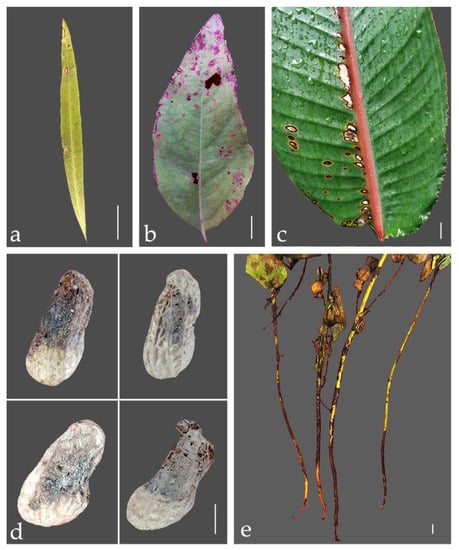
Figure 1.
Field symptoms of diseased plants were collected from this study. (a) Leaf of Callistemon rigidus; (b) Leaf of Eucalyptus sp.; (c) Leaf of Strelitzia reginae; (d) Fruits of Arachis hypogaea; (e) Stems of Cassia surattensis; Scale bars: (a–e) = 1 cm.
2.2. Fungal Isolation
Diseased plant tissues were cut into small pieces (5 × 5 mm) which contained both healthy and diseased tissue. Then the surface was disinfected with 75% ethanol for 15–25 s and 2.5% NaClO for 40 s and rinsed in sterile water three times. After that, tissue pieces were dried on sterilized filter paper inside a laminar flow hood, and placed on potato dextrose agar (PDA) and incubated in the dark at 25 °C. Pure cultures were obtained after three serial transfers of hyphal tips. All cultures obtained in this study were deposited in the culture collection of Zhongkai University of Agriculture and Engineering (ZHKUCC). Herbarium materials (as dry cultures) were deposited in the herbarium of Zhongkai University of Agriculture and Engineering (ZHKU).
2.3. DNA Extraction and PCR Amplification
Genomic DNA was extracted using a DNA rapid Extraction Kit (Aidlab Biotechnologies Co., Ltd., Beijing, China) on 5-day-old cultures grown on PDA. Three loci, the calmodulin (cmdA), the translation elongation factor 1-alpha (tef1-α) and the beta-tubulin (β-tubulin) were amplified and sequenced using primers that were previously designed [,,,] (Table 1). PCR reaction mixtures consisted of 12.5 μL of 2 × Easy Taq PCR SuperMix (TransGen Biotech, Beijing, China), 2 μL DNA, 1 μL of each of the paired 5 μM primers, and ddH2O (8.5 μL). PCR reactions were conducted with an initial step of 95 °C for 3 min, followed by 35 cycles consisting of denaturation at 95 °C for 30 s, annealing from 53 to 55 °C (Table 1) for 30 s and extension at 72 °C for 1 min, and a final extension at 72 °C for 10 min. The reactions were performed in a C1000 TouchTM thermal cycler (Guangzhou Hongtu instrument Co., Ltd., Guangzhou, China). Amplified fragments were sequenced in both directions with forward and reverse primers by Guangzhou Tianyi Science and Technology Co., Ltd. (Guangzhou, China) and consensus sequences derived using BioEdit v.7.0.5.2 []. All sequence data generated in this study were submitted to NCBI GenBank (Supplementary Table S1).

Table 1.
Primers information in this study.
2.4. Phylogenetic Analyses
For all isolates, the genus level was confirmed using the BLASTn tool (Basic Local Alignment Search Tool; https://blast.ncbi.nlm.nih.gov/Blast.cgi) at the National Center for Biotechnology Information (NCBI). To conduct phylogenetic analysis, sequences of Calonectria and other related species were obtained following Liu et al. []. Downloaded sequences were aligned with newly generated sequences using MAFFT v. 7 (https://mafft.cbrc.jp/alignment/server/). Sequences were improved manually when necessary, using BioEdit 7.0.5.2 []. Phylogenetic analyses were performed using concatenated datasets of cmdA, tef1-α and β-tubulin sequence data.
Phylogenetic relationships were inferred using maximum likelihood (ML) in RAxML [] and Bayesian posterior probability analysis (BYPP) in MrBayes (v3.0b4) []. Maximum likelihood analyses and Bayesian analyses were accomplished on the CIPRES science gateway platform (http://www.phylo.org). The GTR + I + G evolution model was used with 1000 non-parametric bootstrapping iterations. The ML analysis was done with RAxML–HPC2 on XSEDE (8.2.8) [,] in the CIPRES Science Gateway platform []. For each phylogenetic tree, 1000 nonparametric bootstrapping iterations were used. Bayesian analyses were based on 2,000,000 generations, sampling every 100 generations, with four simultaneous Markov chains. Bayesian posterior probabilities were calculated after discarding a burn-in phase. The stability of the trees was evaluated by 1000 bootstrap replications. Descriptive statistics were calculated for the resulting trees.
2.5. Pairwise Homoplasy Index (PHI)
To confirm the species novelties, the pairwise homoplasy index (PHI index) was calculated. Here, the PHI index was calculated to determine species boundaries for the taxa with low tree values and significant evolution length. The PHI test was performed using SplitsTree4 v. 4 []. The concatenated three-locus dataset (cmdA + tef1-α + β-tubulin) was used for the analyses. The relationships between isolates belonging to this study and closely related taxa were visualized in split graphs with both the Log-Det transformation and split decomposition options.
2.6. Morphological Characterisation
Representative isolates incubated on carnation leaf agar (CLA) at 25 °C were used for morphological characterization []. Teleomorphic structures such as perithecia, asci and ascospores, and anamorphic structures such as the conidiophores, vesicles and conidia were photographed, and measurements were taken. The Cnoptec SZ650 (Chongqing Optec Instrument Co., Ltd., Chongqing, China) series stereomicroscope was used to observe macro-morphological characteristics. Micromorphological characters were observed using Nikon Eclipse 80i (Nikon, Tokyo, Japan). Morphological features including conidial length, width, and size were measured (at least 40 per isolate) using NISElements BR 3.2.
To observe culture characteristics, representative isolates were grown on malt extract agar (MEA) at 25 °C in the dark []. Colony diameters were examined after seven days with three replicate plates. Colony colors were recorded following the Rayner [] color chart, and textures were observed daily until colonies covered the whole plate.
3. Results
3.1. Phylogenetic Analyses
In total 16 Calonectria isolates were obtained. Phylogenetic analyses for Calonectria species were done using the concatenated dataset of cmdA, tef 1-α and β-tubulin. In total, sequences from 137 Calonectria strains including 16 strains from this study were used. Curvicladiella cignea (CBS 109167 and CBS 109168) was used as the outgroup. Tree topologies derived from the ML and BI analyse were congruent with each other; only the best scoring RAxML tree is presented (Figure 2). The best scoring RAxML tree had -14467.831159 as a final likelihood. The matrix had 998 distinct alignment patterns, with 14.59% of undetermined characters or gaps. Estimated base frequencies were as follows: A = 0.221391, C = 0.308101, G = 0.226807, T = 0.243702; substitution rates AC = 1.449245, AG = 3.672733, AT = 1.291386, CG = 0.870745, CT = 4.692338, GT = 1.000000; gamma distribution shape parameter α = 0.883863. The Bayesian analyses generated 4002 trees (average standard deviation of split frequencies: 0.015016) from which 3002 were sampled after 25% of the trees were discarded as burn-ins. The alignment contained a total of 988 unique site patterns.
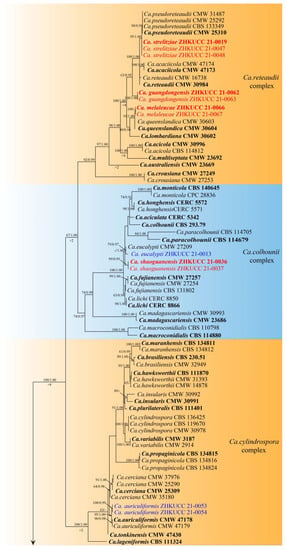
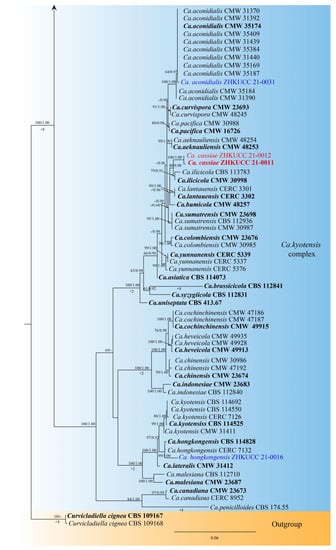
Figure 2.
Phylogenetic tree of Calonectria species based on Maximum Likelihood (ML) analyses of the combined DNA dataset of cmdA, tef1-α and β-tubulin gene sequences. The ML bootstrap support values ≥60% and BYPP higher than 0.90 are indicated above the nodes and branches, and the ×2, ×4, and ×8 below the branches indicate that their lengths are compressed two-, four-, or eight-fold, respectively. The scale bar indicates 0.06 changes per site. Ex-type isolates of Calonectria species are marked in bold. Isolates for already known species in this study are in blue and novel taxa in this study are in red.
In the phylogenetic trees, 16 isolates from this study were clustered in four species complexes in Calonectria: Ca. colhounii, Ca. cylindrospora, Ca. kyotensis and Ca reteaudii. These species formed nine distinct groups, from which four were grouped with already known species and five were novel species.
3.2. PHI Analyses
To confirm the species novelties, the PHI index was calculated. The PHI analysis of five new species (Ca. cassiae, Ca. guangdongensis, Ca. melaleucae, Ca. shaoguanensis and Ca. strelitziae) and closely related taxa did not show significant recombination (the P-value was 1.0, 1.0, 0.06, 1.0 and 1.0, respectively) (Figure 3). This evidence provides support that the new taxa and closely species were different from each other. These results confirmed that these five taxa were different from the already known species of Calonectria.
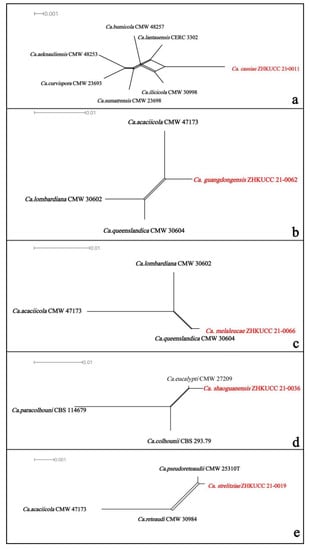
Figure 3.
The results of the pairwise homoplasy index (PHI) test of five Calonectria new species and closely related species using both LogDet transformation and split decomposition. (a) Ca. cassiae; (b) Ca. guangdongensis; (c) Ca. melaleucae; (d) Ca. shaoguanensis; (e) Ca. strelitziae.
3.3. Taxonomy
Calonectria aconidialis L. Lombard, Crous & S.F. Chen bis, Stud. Mycol. 80: 162 (2015) Figure 4.
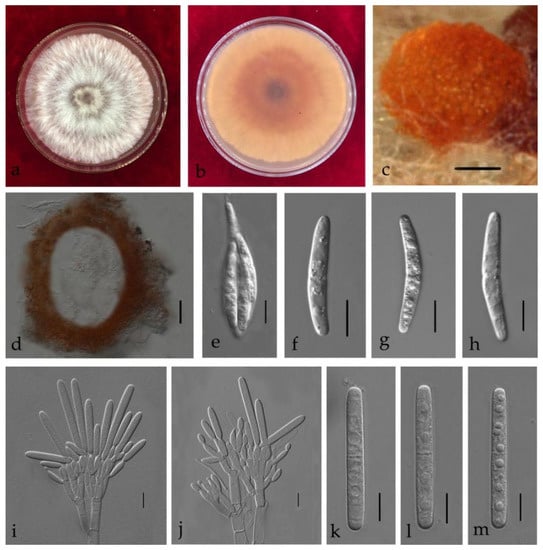
Figure 4.
Calonectria aconidialis (ZHKUCC 21-0031: New host record) (a,b) Culture characteristics on MEA after 7 days ((a), upper view; (b), reverse view); (c) Ascomata; (d) Vertical section through an ascoma; (e) An ascus; (f–h) Ascospores; (i,j) Conidiogenous apparatus; (k–m) Macroconidia; Scale bars: c = 100 μm; d = 50 μm; (e–m) = 10 μm.
Index Fungorum number: IF 809043.
Associated with stem rot of Arachis hypogaea. Telemorph: Perithecia 290–600 × 240–480 µm, solitary, orange–red, subglobose, perithecial walls rough. Asci 110–140 × 15–20 µm, fusiform, eight-spored. Ascospores (32–)37–40(–46) × (5–)6–8(–9) µm ( = 38.5 × 6.5 µm, n = 50), hyaline, fusoid, straight to curved, 1-septate, sometimes constricted at septum. Anamorph: Macroconidiophores 15–25 × 4–6 μm, septate, hyaline. Primary branches of conidiogenous apparatus; secondary branches aseptate, 10–20 × 4–6 μm; tertiary branches 10–15 × 3–6 μm; each terminal branch producing two to four phialides, 10–15 × 3–6 μm. Macroconidia (44–)48–50(–55) × 4–7(–8) μm ( = 49.5 × 7 μm, n = 50), cylindrical, straight, 1-septate. Megaconidia and microconidia not observed.
Culture characteristics—Colonies on MEA fast growing at 25 °C growth rate 11 mm/d (n = 5), circular, producing abundant white aerial mycelium; reverse orange.
Material examined—China, Guangdong Province, Shaoguan City, Arachis hypogaea Linn., (Fabaceae), 27 September 2019, C.T. Chen, dried culture (ZHKU 21-0028), and living culture (ZHKUCC 21-0031).
Notes—One isolate from this study clustered with Ca. aconidialis in the multigene phylogeny with 64% ML and 0.97 BYPP values (Figure 2). Morphologically our isolate is similar to Ca. aconidialis as described by Lombard et al. [] (Table 2). However, Mega, macro and microconidia were not observed in Lombard et al. [], while our isolate produces macroconidia. To our knowledge, this is the first report of Ca. aconidialis from Arachis hypogaea [].
Calonectria auriculiformis N.Q. Pham, T.Q. Pham & M.J. Wingf., Mycologia 111(1): 85 (2019) Figure 5.
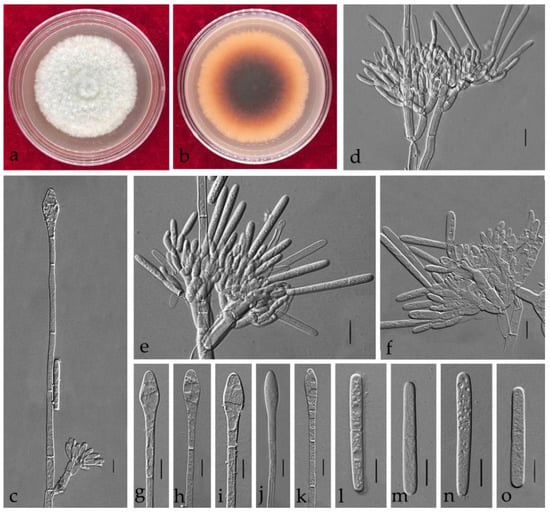
Figure 5.
Calonectria auriculiformis (ZHKUCC 21-0053: New host record) (a,b) Culture characteristics on MEA after 7 days (a) upper view; (b) reverse view); (c) Macroconidiophores; (d–f) Conidiogenous apparatus; (g–k) Vesicles; (l–o) Macroconidia; Scale bars: (c–o) = 10 μm.
Index Fungorum number: IF 825527.
Associated with leaf spot of Eucalyptus sp. Telemorph: not observed. Anamorph: Macroconidiophores septate, hyaline. Primary branches of conidiogenous apparatus 10–30 × 3–10 μm; secondary branches aseptate, 10–25 × 3–8 μm; third branches 10–16 × 3–8 μm; tertiary branches 10–15 × 3–8 μm; each terminal branch producing two to four phialides, 10–20 × 3–6 μm. Vesicles 5–13 μm diamater, ellipsoidal to obpyriform. Macroconidia (38–)40–43(–47) × (3–)4–6 (–7) μm ( = 41.5 × 5 μm, n = 50), cylindrical, straight, 1-septate. Megaconidia and microconidia not observed.
Culture characteristics—Colonies on MEA fast growing at 25 °C, growth rate 9.5 mm/d (n = 5), circular, with regular margin, producing white aerial mycelium; reverse umber.
Material examined—China, Guangdong Province, Guangzhou City, Eucalyptus sp. L.Herit, (Myrtaceae), 11 July 2020, C.T. Chen, dried cultures (ZHKU 21-0050), and living culture (ZHKUCC 21-0053).
Notes—In the phylogenetic tree, two isolates from our study were closed to Ca. auriculiformis with 95% in ML, and 1.00 in BYPP support (Figure 2). Morphologically, our isolates are similar to Ca. auriculiformis described by Pham et al. [] (Table 2).
Calonectria cassiae Y. X. Zhang, C. T. Chen, Manawas., & M. M. Xiang, sp. nov. Figure 6.
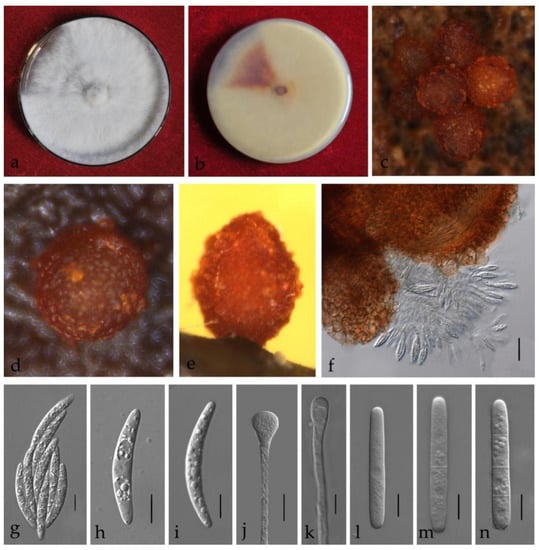
Figure 6.
Calonectria cassiae (ZHKUCC 21-0011: Ex-type) (a,b) Culture characteristics on MEA after 7 days ((a), upper view; (b), reverse view); (c–e) Ascomata; (f,g) Asci; (h,i) Ascospores; (j,k) Vesicles; (l–n) Macroconidia; Scale bars: (c–e) = 100 μm; f = 50 μm; (g–n) = 10 μm.
Index Fungorum number: IF 553370.
Associated with stem rot of Cassia surattensis. Telemorph: Perithecia 400–700 × 350–550 µm, solitary, red–brown, subglobose to ovoid, perithecial walls rough. Asci fusiform with eight-spored. Ascospores 40–50 × 4–8 µm ( = 45 × 6 µm, n = 50), hyaline, fusoid, straight to slightly curved, 1-septate, constricted at septum. Anamorph: Macroconidiophores septate, hyaline. Primary branches of conidiogenous apparatus 15–25 × 4–6 μm; secondary branches aseptate, 10–20 × 4–6 μm; tertiary branches 10–15 × 3–6 μm; each terminal branch producing two to four phialides, 10–15 × 3–6 μm. Vesicles 7–12 μm diameter, sphaeropedunculate. Macroconidia 40–65 × 4–8 μm ( = 54 × 6 μm, n = 50), cylindrical, straight, 1–3-septate. Megaconidia and microconidia not observed.
Culture characteristics—Colonies on MEA fast growing at 25 °C, growth rate 11.2 mm/d (n = 5), circular, producing abundant white aerial mycelium; reverse red brown.
Material examined—China, Guangdong Province, Guangzhou City, Cassia surattensi Burm. F., (Fabaceae), 30 March 2019, Y.X. Zhang, dried culture (ZHKU 21-0008, holotype), and living culture (ZHKUCC 21-0011, ex-type).
Notes—Two isolates obtained in this study developed a distinct sister clade to the Ca. ilicicola clade with 80% in ML and 0.98 in BYPP supports in phylogenetic analyses (Figure 2). Morphologically, the macroconidia of our isolates ( = 54 × 6 μm) are shorter than those of Ca. ilicicola ( = 62 × 6 μm) described by Lombard et al. [] (Table 2), and microconidia were not observed in this study. In the PHI analysis of closely related taxa, there is no significant evidence of recombination among our isolates and other related species (p = 1.0). Therefore, we introduce Ca. cassiae from Cassia surattensis as a novel species based on phylogenetic analyses, morphological analyses and recombination analysis.
Calonectria eucalypti L. Lombard, M.J. Wingf. & Crous, Stud. Mycol. 66: 47 (2010) Figure 7.
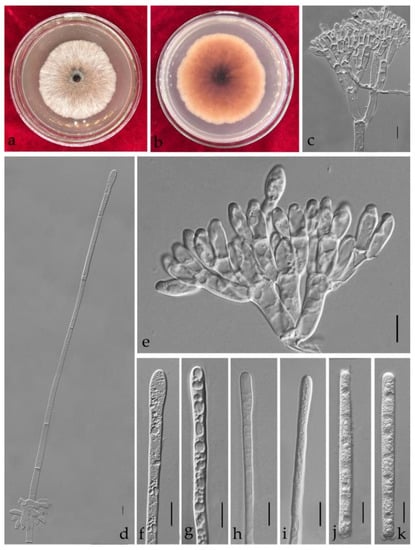
Figure 7.
Calonectria eucalypti (ZHKUCC 21-0013: New host record) (a,b) Culture characteristics on MEA after 7 days (a) upper view; (b) reverse view); (d) Macroconidiophores; (c,e) Conidiogenous apparatus; (f–i) Vesicles; (j,k) Macroconidia; Scale bars: (c–k) = 10 μm.
Index Fungorum number: IF 515530.
Associated with leaf spot of Callistemon rigidus. Telemorph: not observed. Anamorph: Macroconidiophores 15–45 × 4–8 μm, septate, hyaline. Primary branches of conidiogenous apparatus; secondary branches aseptate, 10–25 × 4–8 μm; tertiary branches 10–20 × 3–8 μm; each terminal branch producing two to six phialides, 8–20 × 3–6 μm. Vesicles 4–8 (–10) μm diameter, clavate to broadly clavate. Macroconidia (65–)70–80(–87) × (5–)6 μm ( = 75 × 6.5 μm, n = 50), cylindrical, straight, 1–3-septate. Megaconidia and microconidia not observed.
Culture characteristics—Colonies on MEA at 25 °C, growth rate 8.7 mm/d (n = 5), circular, producing abundant white aerial mycelium; reverse brown.
Material examined—China, Guangdong Province, Guangzhou City, Callistemon rigidus R. Br., (Myrtaceae), 10 November 2020, dried culture (ZHKU 21-0010), and living culture (ZHKUCC 21-0013).
Notes—In the phylogenetic tree, our isolates were grouped with Ca. eucalypti with 79% in ML and 0.97 in BYPP support (Figure 2). The macroconidia of the isolate belonging to this study ( = 75 × 6.5 μm) are similar to the size of the Ca. eucalypti ( = 72 × 6 μm) described by Lombard et al. []. In addition, the vesicle shape and the dimension of our isolate are similar to Ca. eucalypti [] (Table 2). We introduce our isolates from C. rigidus as an anamorph of Ca. eucalypti based on phylogenetic analyses and asexual morphological characteristics. To our knowledge, this is the first report of Ca. eucalypti from Callistemon rigidus [].
Calonectria guangdongensis Y. X. Zhang, C. T. Chen, Manawas., & M. M. Xiang, sp. nov. Figure 8
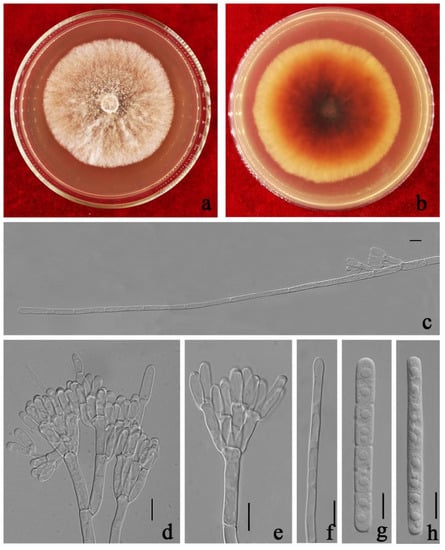
Figure 8.
Calonectriaguangdongensis (ZHKUCC 21-0062: Ex–type) (a,b) Culture characteristics on MEA after 7 days (a), upper view; (b), reverse view); (c) Macroconidiophores; (d,e) Conidiogenous apparatus; (f) Vesicles; (g,h) Macroconidia; Scale bars: (c–h) = 10 μm.
Index Fungorum number: IF 553380.
Etymology—Epithet refers to the Guangdong Province from where the type was collected.
Holotype—ZHKU 21-0059.
Associated with leaf spot of Heliconia metallica. Telemorph: not observed. Anamorph: Macroconidiophores septate, hyaline. Primary branches of conidiogenous apparatus 15–30 × 3–8 μm; secondary branches aseptate, 10–20 × 3–7 μm; tertiary branches aseptate, 10–15 × 3–6 μm; each terminal branch producing two to four phialides, 7–15 × 3–6 μm. Vesicles 3–7 μm diameter, narrowly clavate. Macroconidia 55–70 × 5–7(–9) μm ( = 64 × 6 μm, n = 50), cylindrical, straight, 1–3-septate. Megaconidia and microconidia not observed.
Culture characteristics—Colonies fast growing at 25 °C on MEA, growth rate 9.2 mm/d (n = 5), circular, producing abundant white aerial mycelium, reverse red brown.
Material examined—China, Guangdong Province, Heliconia metallica Planch. et Linden ex Hook. f., (Musaceae). 26 July 2020, Y.X. Zhang, dried cultures (ZHKU 21-0059, holotype), and living culture (ZHKUCC 21-0062, ex-type).
Notes—Our isolates from Heliconia metallica formed a distinct clade from the closely related taxa with 63% ML and 0.95 BYPP support. Morphologically our isolate differs from the other four closely related species by the size of the macroconidia. Our isolate (64 × 6 μm) developed macroconidia smaller than Ca. acaciicola N.Q. Pham, T.Q. Pham & M.J. Wingf. (94 × 7 μm), Ca. pseudoreteaudii L. Lombard, M.J. Wingf. & Crous (104 × 8 μm), Ca. reteaudii C. Booth (84 × 6.5 μm) and Ca. strelitziae (87 × 8 μm) [,,] (Table 2). In the PHI analysis of closely related taxa, there is no significant evidence of recombination among our isolate and other related species (p = 1.0). Based on these polyphasic approaches, we introduce Ca. guangdongensis as a novel species from H. metallica.
Calonectria hongkongensis Crous, Stud. Mycol. 50(2): 422 (2004) Figure 9.
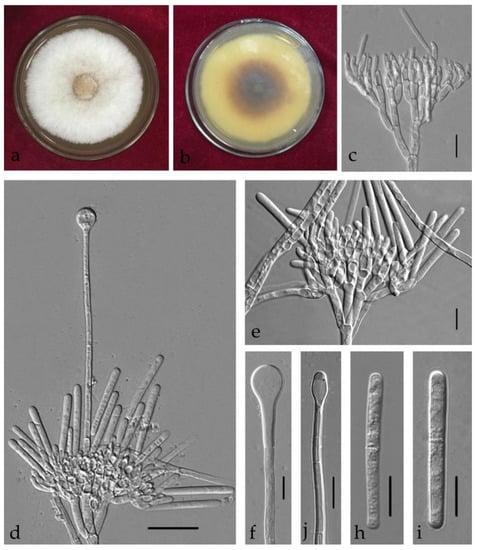
Figure 9.
Calonectria hongkongensis (ZHKUCC 21-0016: New host record) (a,b) Culture characteristics on MEA after 7 days ((a) upper view; (b) reverse view); (d) Macroconidiophores; (c,e) Conidiogenous apparatus; (f–j) Vesicles; (h,i) Macroconidia; Scale bars: (c–i) = 10 μm.
Index Fungorum number: IF 500107.
Associated with leaf spot of Eucalyptus gunnii. Telemorph: not observed. Anamorph: Macroconidiophores septate, hyaline. Primary branches of conidiogenous apparatus 10–20 × 2–4 μm; secondary branches aseptate, 7–15 × 2–4 μm; tertiary branches 6–13 × 2–4 μm; each terminal branch producing two to three phialides, 5–10 × 1–3 μm. Vesicles 8–10 μm diameter, sphaeropedunculate to obpyriform. Macroconidia (38–)40–43(–46) × 4–6 μm ( = 42 × 5 μm, n = 50), cylindrical, straight, 1-septate. Megaconidia and microconidia not observed.
Culture characteristics—Colonies on MEA fast growing at 25 °C, growth rate 10.7 mm/d (n = 5), circular, with regular margin, producing abundant white aerial mycelium; reverse light-yellow to dark-brown.
Material examined—China, Guangdong Province, Guangzhou City, Eucalyptus gunnii Hook, (Myrtaceae), 11 July 2019, C.T. Chen and X. Sun, dried culture (ZHKU 21-0013), and living culture (ZHKUCC 21-0016).
Notes—In the phylogenetic analysis, a single isolate was obtained from Eucalyptus gunnii clustered with Ca. hongkongensis with 99% ML and 1.00 BYPP support (Figure 2). The anamorph of the isolate from this study is similar to Ca. hongkongensis described by Crous et al. [] (Table 2). The telemorph was not observed in this study. To our knowledge, this is the first report of Ca. hongkongensis from E. gunnii [].
Calonectria melaleucae Y. X. Zhang, C. T. Chen, Manawas., & M. M. Xiang, sp. nov. Figure 10.
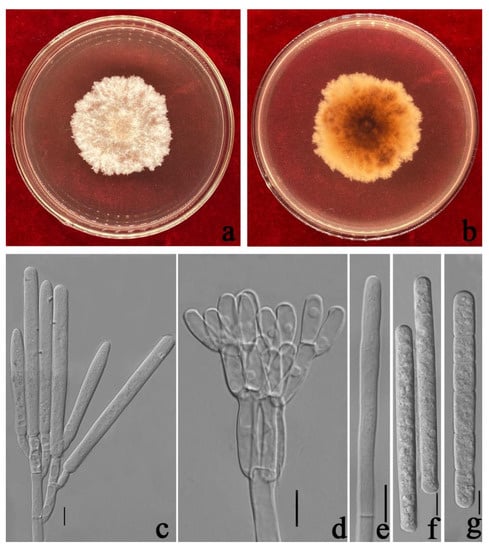
Figure 10.
Calonectriamelaleucae (ZHKUCC 21-0066: Ex–type) (a,b) Culture characteristics on MEA after 7 days (a) upper view; (b) reverse view); (c,d) Conidiogenous apparatus; (e) Vesicle; (f,g) Macroconidia; Scale bars: (c–g) = 10 μm.
Index Fungorum number: IF 553393.
Etymology—Epithet refers to the host (Melaleuca bracteata) from which the type was collected.
Holotype—ZHKU 21-0063.
Associated with leaf spot of Melaleuca bracteata. Telemorph: not observed. Anamorph: Macroconidiophores septate, hyaline. Primary branches of conidiogenous apparatus 15–35 × 3–7 μm; secondary branches aseptate, 15–25 × 3–6 μm; tertiary branches aseptate, 10–20 × 3–5 μm; each terminal branch producing two to four phialides, 10–15 × 3–5 μm. Vesicles 3–7 μm diameter, narrowly clavate. Macroconidia 80–95(–100) × (5–)7–10 μm ( = 88 × 8 μm, n = 50), cylindrical, straight, 3–5-septate. Megaconidia and microconidia not observed.
Culture characteristics—Colonies fast growing at 25 °C on MEA, growth rate 7.2 mm/d (n = 5), circular, producing abundant white aerial mycelium, reverse lightly red brown.
Material examined—China, Guangdong Province, Guangzhou City, Melaleuca bracteata F. Muell., (Myrtaceae). 26 July 2020, Y.X. Zhang, dried cultures (ZHKU 21-0063 holotype), and living culture (ZHKUCC 21-0066, ex–type).
Notes—Our isolates from Melaleuca bracteata formed a distinct clade sister to Ca. queenslandica L. Lombard, M.J. Wingf. & Crous with 91% in ML and 1.00 in BYPP support. Our isolate differs from Ca. queenslandica by the size of the macroconidia []. Our isolate (88 × 8 μm) developed macroconidia larger than Ca. queenslandica (69 × 6 μm). In addition, our isolates are different from Ca. queenslandica in the number of macroconidia septa [3–5 vs. 4–6], as well as the size of vesicles (3–7 vs. 3–4 μm diameter) [] (Table 2). In the PHI analysis of closely related taxa, there is no significant evidence of recombination among our isolate and other related species (p = 0.06). Based on these polyphasic approaches, we introduce Ca. melaleucae as a novel species from M. bracteata.
Calonectria shaoguanensis Y. X. Zhang, C. T. Chen, Manawas., & M. M. Xiang, sp. nov. Figure 11.
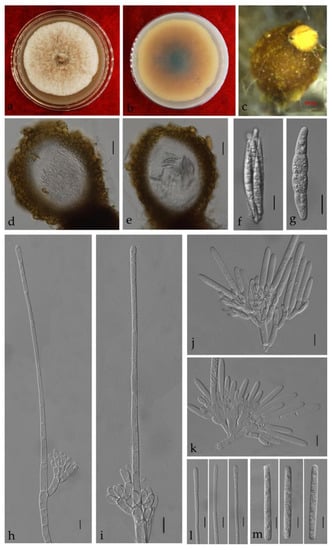
Figure 11.
Calonectria shaoguanensis (ZHKUCC 21-0036: Ex-type) (a,b) Culture characteristics on MEA after 7 days (a) upper view; (b) reverse view); (c) Ascomata; (d,e) Vertical section through ascomata; (f) An ascus; (g) A ascospore; (h,i) Macroconidiophores; (j,k) Conidiogenous apparatus; (l) Vesicles; (m) Macroconidia; Scale bars: (c) = 100 μm; (d,e) = 50 μm; (f–m) = 10 μm.
Index Fungorum number: IF 555217.
Etymology—Epithet refers to the Shaoguan city from where the type was collected.
Holotype—ZHKU 21-0033.
Associated with leaf spot of Callistemon rigidus. Telemorph: Perithecia 250–500 × 200–380 µm, solitary, yellow, subglobose to ovoid, and rough perithecial walls. Asci fusiform, eight-spored. Ascospores (45–)50–70 × (3–)4–8(–9) µm ( = 56.5 × 6.5 µm, n = 50), hyaline, fusiform, straight to curved, 1-septate, sometimes constricted at septum. Anamorph: Macroconidiophores septate, hyaline. Primary branches of conidiogenous apparatus 10–25 × 3–8 μm; secondary branches aseptate, 10–18 × 3–7 μm; tertiary branches aseptate, 8–15 × 3–6 μm; each terminal branch producing two to four phialides, 7–12 × 2–5 μm. Vesicles (2–)4–7 μm diameter, narrowly clavate. Macroconidia (55–)60–70(–75) × (4–)5–8 μm ( = 65 × 6.5 μm, n = 50), cylindrical, straight, 1–3-septate. Megaconidia and microconidia not observed.
Culture characteristics—Colonies fast growing at 25 °C on MEA, growth rate 10 mm/d (n = 5), circular, producing abundant white aerial mycelium, reverse red brown.
Material examined—China, Guangdong Province, Shaoguan City, Callistemon rigidus R. Br., (Myrtaceae). 21 June 2020, Y.X. Zhang, dried cultures (ZHKU 21-0033 holotype), and living culture (ZHKUCC 21-0036 ex-type).
Notes—Our isolates from Callistemon rigidus formed a distinct clade from the other six closely related species with less than 60% ML and 1.00 BYPP support (Figure 2). Morphologically our isolate differs from Ca. eucalypti by the size of the macroconidia []. Our isolate (65 × 6.5 μm) developed macroconidia shorter than the two isolates of Ca. eucalypti described by Lombard et al. (72 × 6 μm) [] and in this study (75 × 6.5 μm). In the PHI analysis of closely related taxa, there is no significant evidence of recombination among our isolate and other related species (p = 1.0). Based on these polyphasic approaches we introduce Ca. shaoguanensis as a novel species from C. rigidus.
Calonectria strelitziae Y. X. Zhang, C. T. Chen, Manawas., & M. M. Xiang, sp. nov. Figure 12.
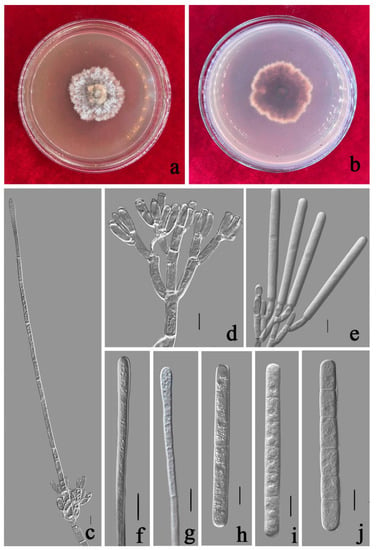
Figure 12.
Calonectria strelitziae (ZHKUCC 21-0019: Ex-type) (a,b) Culture characteristics on MEA after 7 days (a) upper view; (b) reverse view); (c) Macroconidiophores; (d,e) Conidiogenous apparatus; (f,g) Vesicles; (h–j) Macroconidia; Scale bars: (c–j) = 10 μm.
Index Fungorum number: IF 553395.
Etymology—Epithet refers to the host (Strelitzia reginae) from which the type was collected.
Holotype—ZHKU 21-0016.
Associated with leaf spot of Strelitzia reginae. Telemorph: not observed. Anamorph: Macroconidiophores septate, hyaline. Primary branches of conidiogenous apparatus 15–30 × 3–9 μm; secondary branches aseptate, 10–25 × 3–9 μm; tertiary branches aseptate, 10–25 × 4–8 μm; each terminal branch producing two to four phialides, 10–20 × 3–8 μm. Vesicles 3–8 μm diameter, narrowly clavate. Macroconidia (65–)80–95(–115) × (4–)6–10(–12) μm ( = 87 × 8 μm, n = 50), cylindrical, straight, 3–5-septate. Microconidia 45–55 × 4.7–5.5 ( = 49 × 5.1 μm, n = 9), cylindrical, 1-septate. Megaconidia not observed.
Culture characteristics—Colonies fast growing at 25 °C on MEA, growth rate 5.4 mm/d (n = 5), circular, with irregular edge, producing white aerial mycelium, reverse red brown.
Material examined—China, Guangdong Province, Guangzhou City, Strelitzia reginae Aiton, (Musaceae). 11 July 2020, Y.X. Zhang and C.T. Chen, dried cultures (ZHKU 21-0016, holotype), and living culture (ZHKUCC 21-0019, ex-type).
Notes—Our isolates from Strelitzia reginae formed a single lineage sister to Ca. pseudoreteaudii with 95% in ML, and 1.00 in BYPP support (Figure 2). Morphologically our isolate differs from Ca. pseudoreteaudii by the shorter macroconidia (87 × 8 μm vs. 104 × 8 μm) and smaller microconidia (49 × 5 μm vs. 44 × 4 μm) [] (Table 2). In the PHI analysis of closely related taxa, there is no significant evidence of recombination among our isolate and other related species (p = 1.0). Based on these polyphasic approaches, we introduce Ca. strelitziae as a novel species from S. reginae.

Table 2.
Morphological comparison of Calonectria species obtained in this study with their relatives.
Table 2.
Morphological comparison of Calonectria species obtained in this study with their relatives.
| Complex | Species | Ascospores | Macroconidia | Vesicle | References | |||
|---|---|---|---|---|---|---|---|---|
| Size/μm | Septa | Size/μm | Septa | Shape | Diam/μm | |||
| Ca. colhounii | Ca. eucalypti | (25–)30–36(–56) × (3–)5–6(–8) = 33 × 6 | (1–)3 | (66–)69–75(–80) × (5–)6 = 72 × 6 | 3 | broad clavate | 4–6 | [] |
| Ca. eucalypti | / | / | (65–)70–80(–87) × (5–)6 = 75 × 6.5 | 1–3 | Clavate to broad clavate | 4–10 | (This study) | |
| Ca. shaoguanensis | (45–)50–70 × (3–)4–8(–9) = 56.5 × 6.5 | 1 | (55–)60–70(–75) × (4–)5–8 = 65 × 6.5 | 1–3 | narrowly clavate | (2–)4–7 | (This study) | |
| Ca. kyotensis | Ca. ilicicola | = 45 × 6 | 1 | = 62 × 6 | 1(–3) | sphaeropedunculate | 8–12 | [] |
| Ca. cassiae | 40–50 × 4–8 = 45 × 6 | 1 | 40–65 × 4–8 = 54 × 6 | 1–3 | sphaeropedunculate | 8–12 | (This study) | |
| Ca. reteaudii | Ca. strelitziae | / | / | (65–)80–95(–115) × (4–)6–10(–12) = 87 × 8 | 3–5 | narrowly clavate to broad clavate | 3–8 | (This study) |
| Ca. pseudoreteaudii | / | / | (88–)96–112(–119) × 7–9(–10) = 104 × 8 | 5–8 | narrowly clavate | 3–5 | [] | |
| Ca. acaciicola | / | / | (85–)90–98(–105) × (6–)6.5–7.5 = 94 × 7 | 5 | narrowly clavate | 4–7 | [] | |
| Ca. reteaudii | / | / | (50–)75–95(–120) × (5–)6–7 = 84 × 6.5 | (1–) 5(–6) | clavate | 3–5(–6) | [] | |
| Ca. guangdongensis | / | / | 55–70 × 5–7(–9) = 64 × 6 | 1–3 | narrowly clavate | 3–7 | (This study) | |
| Ca. melaleucae | / | / | 80–95(–100) × (5–)7–10 = 88 × 8 | 3–5 | narrowly clavate | 3–7 | (This study) | |
| Ca. queenslandica | / | / | (61–)65–73(–78) × (4–)5–6(–7) = 69 × 6 | 4–6 | narrowly clavate | 3–4 | [] | |
| Ca. lombardiana | / | / | (64–)74–86(–98) × (5–)5.5–6.5(–7.5) = 80 × 6 | 5 | narrowly clavate | 2–4 | [] | |
4. Discussion
Species identification is the most important step in plant pathology to develop control measures [,]. Thus, proper species identification is necessary following polyphasic approaches [,,,]. Calonectria represents one of the most important phytopathogenic genera in Nectriaceae []. In the present study, we isolated and identified seven Calonectria species associated with various leaf and root diseases from eight different hosts in China. These species were identified as five novel species: Ca. cassiae, Ca. guangdongensis, Ca. melaleucae, Ca. shaoguanensis and Ca. strelitziae, as well as four new host records: Ca. aconidialis from Arachis hypogaea, Ca. auriculiformis from Eucalyptus sp., Ca. eucalypti from Callistemon rigidus, and Ca. hongkongensis from Eucalyptus gunnii. Calonectria species belong to 11 species complexes [] revealing that the diversity among these species is considerably high. Thus, the use of either morphology or phylogeny alone is difficult to provide strong support to delineate the species [,]. Therefore, in the present study, we used polyphasic approaches including morphology, phylogeny and recombination analysis to introduce novel species.
In this study, four Calonectria species were identified as new host records. Calonectria eucalypti were isolated from Eucalyptus grandis leaf from Sumatera Utara []. Here Ca. eucalypti is reported to be associated with leaf spots on Callistemon rigidus. Previous studies have mentioned that Ca. colhounii Peerally, Ca. kyotensis Terash. and Ca. pteridis Crous, M.J. Wingf. & Alfenas are associated with C. rigidus [], and our collection, Ca. eucalypti will be a new addition. Calonectria aconidialis was introduced as a soil fungus from Eucalyptus plantation []. In the present study, Ca. aconidialis was isolated from rotted A. hypogaea pods. There are no host records for Ca. aconidialis worldwide []. Therefore, our study provides a novel ecological niche for Ca. aconidialis. However, further studies are required to understand the host shifting and pathogenicity mechanisms of this fungus.
Calonectria hongkongensis was described by Crous et al. from the soil in Hong Kong []. Up to now, 15 Calonectria species, including Ca. hongkongensis, have been isolated from Eucalyptus plants or plantation soils in China []. This species was only isolated from Eucalyptus plantation soil and was not identified as a pathogen on Eucalyptus leaves [,,]. Therefore, Ca. hongkongensis is considered a soil-borne species that inhabits the soil []. This is the first report of Ca. hongkongensis being isolated from diseased E. gunnii roots, reflecting that this species can be a potential soil-borne pathogen in Eucalyptus plantations. Calonectria auriculiformis was described by Pham et al. from Acacia auriculiformis plantation soil in Vietnam []. Later it was isolated from soil in E. urophylla hybrid plantations in China []. Similar to Ca. hongkongensis, Ca. auriculiformis has not been reported as a plant pathogen in previous studies. In the present study, we isolated Ca. auriculiformis from diseased leaves of Eucalyptus in Guangdong, China. However, further assays including controlled inoculation studies are required to confirm the pathogenicity of these isolated taxa.
Calonectria shaoguanensis was introduced as a new species, while adding one more species to the Ca. colhounii complex. This species complex includes 11 species: Ca. aciculata Jie Q. Li, Q.L. Liu & S.F. Chen, Ca. colhounii, Ca. eucalypti, Ca. fujianensis S.F. Chen, L. Lombard, M.J. Wingf. & X.D. Zhou, Ca. honghensis Jie Q. Li, Q.L. Liu & S.F. Chen, Ca. indusiata (Seaver) Crous, Ca. lichi Q.L. Liu & S.F. Chen, Ca. macroconidialis (Crous, M.J. Wingf. & Alfenas) Crous, Ca. madagascariensis Crous, Ca. monticola L. Lombard & Crous and Ca. paracolhounii L. Lombard & Crous []. Calonectria shaoguanensis can be distinguished from its closely related species by its macroconidial dimensions and by the shape of vesicles as well as by the number of ascosporous septa and macroconidial septa []. This species was isolated from Callistemon rigidus leaf spot. There have been three Calonectria species found on C. rigidus previously [].
Three novel species, Ca. guangdongensis, Ca. melaleucae and Ca. strelitziae were added into the Ca. reteaudii complex, which accommodates nine species []. Species in the Ca. reteaudii complex have narrowly clavate vesicles, orange to red–brown perithecia and generally >3-septate macroconidia []. These three new species differ from closely related taxa by the size of macroconidia, Ca. guangdongensis and Ca. strelitziae developed shorter macroconidia, Ca. melaleucae formed larger macroconidia [,,,]. In addition, the macroconidia septa number of Ca. guangdongensis was one to three, similar to that of Ca. crousiana and Ca. australiensis, while distinct from most species having over 3-septate macroconidia in the Ca. reteaudii complex []. Calonectria cassiae was introduced as a new species while adding one more species to the Ca. kyotensis complex, which is a larger complex with twenty-four species []. The novel species differ from closely related species Ca. ilicicola by producing shorter macroconidia []. Until now, there are fifteen fungal species associated with Cassia surattensis, while there are no previous records from Calonectria species []. This is the first report of Calonectria species being associated with C. surattensis stem and root rots.
Overall, in the present study, novel Calonectria species and new host records were identified. Here, these taxa were isolated from diseased plant tissues including leaf spots, stem and root rots. However, the pathogenicity of these isolates was not confirmed in this study. The identification and characterization of novel taxa from southern China contributes to the knowledge of the biodiversity resources in tropical regions. Moreover, this study adds information on the taxonomy and diversity of Calonectria species in China. Future studies are required to confirm the pathogenicity of these isolated species on different plant hosts, and to examine their biology and ecology.
Supplementary Materials
The following supporting information can be downloaded at: https://www.mdpi.com/article/10.3390/jof8070719/s1, Table S1. GeneBank accession numbers of Calonectria strains used in phylogenetic analysis.
Author Contributions
Conceptualization, Y.Z. and I.S.M.; methodology, Y.Z.; software, C.C. (Cantian Chen), C.C. (Chao Chen) and J.C.; validation, Y.Z. and C.C. (Cantian Chen); formal analysis, Y.Z., C.C. (Cantian Chen) and C.C. (Chao Chen); investigation, Y.Z. and C.C. (Cantian Chen); resources, Y.Z. and C.C. (Cantian Chen); data curation, Y.Z. and C.C. (Cantian Chen); writing—original draft preparation, Y.Z.; writing—review and editing, Y.Z., I.S.M., D.N.W., T.H. and K.D.H.; visualization, C.C. (Chao Chen) and C.C. (Cantian Chen); supervision, I.S.M. and M.X.; project administration, Y.Z.; funding acquisition, Y.Z. All authors have read and agreed to the published version of the manuscript.
Funding
This research was funded by the National Natural Science Foundation of China (grant no. 31600019), Modern Agricultural Industry Technology System Flower Innovation Team of Guangdong Province (grant no. 2021KJ121 and 2022KJ121), the Project of Educational Commission of Guangdong Province of China (grant no. 2021KTSCX045) and Key Realm R&D Program of Guangdong Province (grant no. 2018B020205003). Ishara S. Manawasinghe would like to thank Zhongkai University of Agriculture and Engineering, Guangzhou 510225, P.R China for research funding (grant no. KA210319288).
Institutional Review Board Statement
Not applicable.
Informed Consent Statement
Not applicable.
Data Availability Statement
All sequence data generated in this study is deposited in NCBI GenBank and accession numbers are given in the Supplementary Materials.
Acknowledgments
We would like to thank Shaun Pennycook, Nomenclature Editor, Mycotaxon, for his guidance on the species names. We also would like to thank Paul Kirk, Royal Botanic Gardens Kew, for his help with new species name registration in Index Fungorum.
Conflicts of Interest
The authors declare no conflict of interest.
References
- Rossman, A.Y. Calonectria and its type species, Calonectria daldiniana, a later synonym of Calonectria pyrochroa. Mycotaxon 1979, 8, 321–328. [Google Scholar]
- Crous, P.W.; Wingfield, M.J. A monograph of Cylindrocladium, including anamorphs of Calonectria. Mycotaxon 1994, 51, 393–404. [Google Scholar]
- Liu, Q.L.; Li, J.; Wingfield, M.J.; Duong, T.A.; Wingfield, B.D.; Crous, P.W.; Chen, S.F. Reconsideration of species boundaries and proposed DNA barcodes for Calonectria. Stud. Mycol. 2020, 97, 1–73. [Google Scholar] [CrossRef]
- Crous, P.W.; Hernández-Restrepo, M.; Schumacher, R.K.; Cowan, D.A.; Maggs-Kölling, G.; Marais, E.; Wingfield, M.J.; Yilmaz, N.; Adan, O.C.G.; Akulov, A.; et al. New and interesting fungi. 4. Fungal Syst. Evol. 2021, 7, 255–343. [Google Scholar] [CrossRef] [PubMed]
- Mohali, S.R.; Stewart, J.E. Calonectria vigiensis sp. nov. (Hypocreales, Nectriaceae) associated with dieback and sudden-death symptoms of Theobroma cacao from Mérida state, Venezuela. Botany 2021, 99, 683–693. [Google Scholar] [CrossRef]
- Pham, N.Q.; Marincowitz, S.; Chen, S.; Yaparudin, Y.; Wingfield, M.J. Calonectria species, including four novel taxa, associated with Eucalyptus in Malaysia. Mycol. Prog. 2022, 21, 181–197. [Google Scholar] [CrossRef]
- Index Fungorum. 2022. Available online: http://www.indexfungorum.org/Names/Names.asp (accessed on 11 March 2022).
- Crous, P.W.; Phillips, A.J.L.; Wingfield, M.J. The genera Cylindrocladium and Cylindrocladiella in South Africa, with special reference to forest nurseries. S. Afr. For. J. 1991, 157, 69–85. [Google Scholar]
- Crous, P.W. Taxonomy and Pathology of Cylindrocladium (Calonectria) and Allied Genera; American Phytopathological Society (APS Press.): Saint Paul, MI, USA, 2002. [Google Scholar]
- Pan, R.; Guan, M.; Xu, D.; Gao, X.; Yan, X.; Liao, H. Cylindrocladium black rot caused by Cylindrocludium parasiticum newly reported on peanut in China. Plant Pathol. 2009, 58, 1176. [Google Scholar] [CrossRef]
- Alfenas, R.F.; Lombard, L.; Pereira, O.L.; Alfenas, A.C.; Crous, P.W. Diversity and potential impact of Calonectria species in Eucalyptus plantations in Brazil. Stud. Mycol. 2015, 80, 89–130. [Google Scholar] [CrossRef] [Green Version]
- Gehesquière, B.; Crouch, J.A.; Marra, R.E.; Van Poucke, K.; Rys, F.; Maes, M.; Heungens, K. Characterization and taxonomic reassessment of the box blight pathogen Calonectria pseudonaviculata, introducing Calonectria henricotiae sp. nov. Plant Pathol. 2016, 65, 37–52. [Google Scholar] [CrossRef]
- Gai, Y.; Deng, Q.; Chen, X.; Guan, M.; Xiao, X.; Xu, D.; Pan, R. Phylogenetic diversity of Calonectria ilicicola causing Cylindrocladium black rot of peanut and red crown rot of soybean in southern China. J. Gen. Plant Pathol. 2017, 83, 273–282. [Google Scholar] [CrossRef]
- Lombard, L.; Zhou, X.D.; Crous, P.W.; Wingfield, B.D.; Wingfield, M.J. Calonectria species associated with cutting rot of Eucalyptus. Persoonia 2010, 24, 1–11. [Google Scholar] [CrossRef] [Green Version]
- Chen, S.; Lombard, L.; Roux, J.; Xie, Y.; Wingfield, M.J.; Zhou, X.D. Novel species of Calonectria associated with Eucalyptus leaf blight in Southeast China. Persoonia 2011, 26, 1–12. [Google Scholar] [CrossRef] [Green Version]
- Lombard, L.; Chen, S.F.; Mou, X.; Zhou, X.D.; Crous, P.W.; Wingfield, M.J. New species, hyper-diversity and potential importance of Calonectria spp. from Eucalyptus in South China. Stud. Mycol. 2015, 80, 151–188. [Google Scholar] [CrossRef] [Green Version]
- Wu, W.; Chen, S. Species diversity, mating strategy and pathogenicity of Calonectria species from diseased leaves and soils in the Eucalyptus plantation in southern China. J. Fungi 2021, 7, 73. [Google Scholar] [CrossRef]
- Carbone, I.; Kohn, L.M. A method for designing primer sets for speciation studies in filamentous ascomycetes. Mycologia 1999, 91, 553–556. [Google Scholar] [CrossRef]
- O’Donnell, K.; Kistler, H.C.; Cigelnik, E.; Ploetz, R.C. Multiple evolutionary origins of the fungus causing Panama disease of banana: Concordant evidence from nuclear and mitochondrial gene genealogies. Proc. Natl. Acad. Sci. USA 1998, 95, 2044–2049. [Google Scholar] [CrossRef] [Green Version]
- Donnell, K.O.; Cigelnik, E. Two divergent intragenomic rDNA ITS2 types within a monophyletic lineage of the fungus Fusarium are nonorthologous. Mol. Phylogenet. Evol. 1997, 7, 103–116. [Google Scholar] [CrossRef]
- Crous, P.W.; Groenewald, J.Z.; Risède, J.M.; Simoneau, P.; Hywel-Jones, N.L. Calonectria species and their Cylindrocladium anamorphs: Species with sphaeropedunculate vesicles. Stud. Mycol. 2004, 50, 415–430. [Google Scholar]
- Hall, T.A. BioEdit: A user-friendly biological sequence alignment editor and analysis program for Windows 95/98/NT. Nucleic Acid Symp. Ser. 1999, 41, 95–98. [Google Scholar]
- Silvestro, D.; Michalak, I. RaxmlGUI: A graphical front-end for RAxML. Org. Divers. Evol. 2012, 12, 335–337. [Google Scholar] [CrossRef]
- Ronquist, F.; Huelsenbeck, J.P. MrBayes 3: Bayesian phylogenetic inference under mixed models. Bioinformatics 2003, 19, 1572–1574. [Google Scholar] [CrossRef] [Green Version]
- Stamatakis, A.; Hoover, P.; Rougemont, J. A rapid bootstrap algorithm for the RAxML web servers. Syst. Biol. 2008, 57, 758–771. [Google Scholar] [CrossRef]
- Stamatakis, A. RAxML version 8: A tool for phylogenetic analysis and post-analysis of large phylogenies. Bioinformatics 2014, 30, 1312–1313. [Google Scholar] [CrossRef]
- Miller, M.A.; Pfeiffer, W.T.; Schwartz, T. Creating the CIPRES Science Gateway for Inference of Large Phylogenetic Trees. In Gateway Computing Environments Workshop (GCE); Institute of Electrical and Electronics, Engineers: New Orleans, LA, USA, 2010. [Google Scholar]
- Huson, D.H.; Bryant, D. Application of phylogenetic networks in evolutionary studies. Mol. Biol. Evol. 2006, 23, 254–267. [Google Scholar] [CrossRef]
- Rayner, R.W. A Mycological Colour Chart; Commonwealth Mycological Institute and British Mycological Society: Kew, UK, 1970. [Google Scholar]
- Farr, D.F.; Rossman, A.Y. Fungal Databases, U.S. National Fungus Collections, ARS, USDA. Available online: https://nt.ars-grin.gov/fungaldatabases/ (accessed on 11 March 2022).
- Pham, N.Q.; Barnes, I.; Chen, S.; Liu, F.; Dang, Q.N.; Pham, T.Q.; Wingfield, M.J. Ten new species of Calonectria from Indonesia and Vietnam. Mycologia 2019, 111, 78–102. [Google Scholar] [CrossRef]
- Lombard, L.; Crous, P.W.; Wingfield, B.D.; Wingfield, M.J. Phylogeny and systematics of the genus Calonectria. Stud. Mycol. 2010, 66, 31–69. [Google Scholar] [CrossRef]
- Manawasinghe, I.S.; Phillips, A.J.L.; Xu, J.; Balasuriya, A.; Hyde, K.D.; Tępień, L.; Harischandra, D.L.; Karunarathna, A.; Yan, J.; Weerasinghe, J.; et al. Defining a species in fungal plant pathology: Beyond the species level. Fungal Divers. 2021, 109, 267–282. [Google Scholar] [CrossRef]
- Chethana, K.W.; Manawasinghe, I.S.; Hurdeal, V.G.; Bhunjun, C.S.; Appadoo, M.A.; Gentekaki, E.; Raspé, O.; Promputtha, I.; Hyde, K.D. What are fungal species and how to delineate them? Fungal. Divers. 2021, 109, 1–25. [Google Scholar] [CrossRef]
- Jayawardena, R.S.; Hyde, K.D.; de Farias, A.R.G.; Bhunjun, C.S.; Ferdinandez, H.S.; Manamgoda, D.S.; Thines, M. What is a species in fungal plant pathogens? Fungal Divers. 2021, 109, 239–266. [Google Scholar] [CrossRef]
- Maharachchikumbura, S.S.; Chen, Y.; Ariyawansa, H.A.; Hyde, K.D.; Haelewaters, D.; Perera, R.H.; Samarakoon, M.C.; Wanasinghe, D.N.; Bustamante, D.E.; Liu, J.K. Integrative approaches for species delimitation in Ascomycota. Fungal Divers. 2021, 109, 155–179. [Google Scholar] [CrossRef]
- Jayawardena, R.S.; Hyde, K.D.; Jeewon, R.; Ghobad-Nejhad, M.; Wanasinghe, D.N.; Liu, N.; Phillips, A.J.L.; Oliveira-Filho, J.R.C.; da Silva, G.A.; Gibertoni, T.B.; et al. One stop shop ii: Taxonomic update with molecular phylogeny for important phytopathogenic genera: 26–50. Fungal Divers. 2019, 94, 41–129. [Google Scholar] [CrossRef]
- Li, J.; Wingfield, M.J.; Liu, Q.; Barnes, I.; Roux, J.; Lombard, L.; Crous, P.W.; Chen, S.F. Calonectria species isolated from Eucalyptus plantations and nurseries in South China. IMA fungus 2017, 8, 259–286. [Google Scholar] [CrossRef] [Green Version]
Publisher’s Note: MDPI stays neutral with regard to jurisdictional claims in published maps and institutional affiliations. |
© 2022 by the authors. Licensee MDPI, Basel, Switzerland. This article is an open access article distributed under the terms and conditions of the Creative Commons Attribution (CC BY) license (https://creativecommons.org/licenses/by/4.0/).